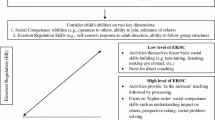Abstract
This paper describes an approach to working with egoimpaired children and adolescents. The structure and process of psychotherapy groups within a residential program are discussed. We describe how insight-oriented groups act as a collective superego, thereby encouraging maturation. Functions of the group relating to socialization, milieu issues, peer issues, family relationships, personal issues, selfesteem, empowerment, and special issues are discussed. The focus of the discussion is on the structure and process of the groups. Brief clinical vignettes are utilized to illustrate components of the approach.
Similar content being viewed by others
References
Allen, D. (1989). Depressive characteristics of physically abused children.Journal of Abnormal Psychology, 17, 1–11.
Berkovitz, I. (1972).Adolescents grow in groups. New York: Brunner/Mazel.
Berkovitz, I., & Sugar, M. (1975). Implications and contradictions for adolescent group psychotherapy. In M. Sugar (Ed.),The adolescent in group and family therapy. New York: Brunner/Mazel.
Bernfeld, G., Clark, L., & Parker, G. (1984). The process of adolescent group psychotherapy.International Journal of Group Psychotherapy, 34, 111–126.
Cerda, R., Nemiroff, H., & Richmond, A. (1991). Therapeutic group approaches in an inpatient facility for children and adolescents: A 15-year perspective.Group, 15, 71–80.
Charach, R. (1983). Brief interpretive psychotherapy with early latency-age children.International Journal of Group Psychotherapy, 33, 349–363.
Chase, J. (1991). Inpatient adolescent and latency-age children's perspective on the curative factors in group psychotherapy.Group, 15, 95–108.
Dannefer, E., Brown, R., & Epstein, N. (1975). Experience in developing a combined activity and verbal group therapy program with latency age boys.International Journal of Group Psychotherapy, 25, 331–339.
Gardner, R. (1975).Psychotherapeutic approach to the disturbed child. New York: Jason Aronson.
Gold, E. (1986). Long-term effects of victimization in childhood.Journal of Consulting and Clinical Psychology, 54, 471–475.
Kinseth, L. (1982). Spontaneous nonverbal intervention in group therapy.International Journal of Group Psychotherapy, 32, 327–338.
Kraft, I. (1968). An overview of group psychotherapy with adolescents.International Journal of Group Psychotherapy, 18, 461–480.
Lockwood, J. (1981). Treatment of disturbed children in verbal and experiential group psychotherapy.International Journal of Group Psychotherapy, 31, 355–366.
Matsushima, J. (1965). Some aspects of defining “success” in residential treatment.Child Welfare, 44, 272–277.
Mosholder, A., Burke, W., & Carter, W. (1988). Insight-oriented group psychotherapy for latencyage children in an acute care setting.Group, 12, 226–232.
Peck, H., & Bellsmith, V. (1954).Treatment of the delinquent adolescent. New York: Family Service Association of America.
Rose, M. (1986). The design of atmosphere: Ego-nurture and psychic change in residential treatment.Journal of Adolescence, 9, 49–62.
Sands, R., & Golub, S. (1974). Breaking the bonds of tradition: A reassessment of group treatment of latency-age children.American Journal of Psychiatry, 131, 663–665.
Schaefer, C., Johnson, L., & Wherry, J. (1982). Introduction: Principles underlying group therapies for children and youth. In C. Schaefer, L. Johnson, & J. Wherry (Eds.),Group therapies for children and youth. San Francisco: Jossey-Bass.
Schamess, G. (1976). Group treatment modalities for latency-age children.International Journal of Group Psychotherapy, 26, 455–474.
Slavson, S. (1943).An introduction to group psychotherapy. New York: International Universities Press.
Spinner, D., & Pfeifer, G. (1986). Group psychotherapy with ego impaired children: The significance of peer group culture in the evolution of a holding environment.International Journal of Group Psychotherapy, 36, 427–446.
Sugar, M. (1979). Integration of therapeutic modalities in the treatment of an adolescent.International Journal of Group Psychotherapy, 29, 509–522.
Whittaker, J., Overstreet, E., Grasso, A., Tripodi, T., & Boylan, F. (1988). Multiple indicators of success in residential youth care and treatment.American Journal of Orthopsychiatry, 58, 143–147.
Author information
Authors and Affiliations
Rights and permissions
About this article
Cite this article
Winek, J.L., Faulkner, M.A. Group psychotherapy as a technique for assisting ego-impaired children and adolescents. Group 18, 112–122 (1994). https://doi.org/10.1007/BF01457422
Issue Date:
DOI: https://doi.org/10.1007/BF01457422




